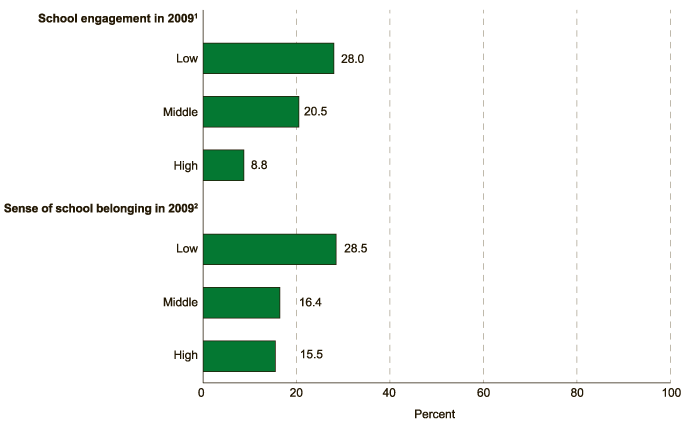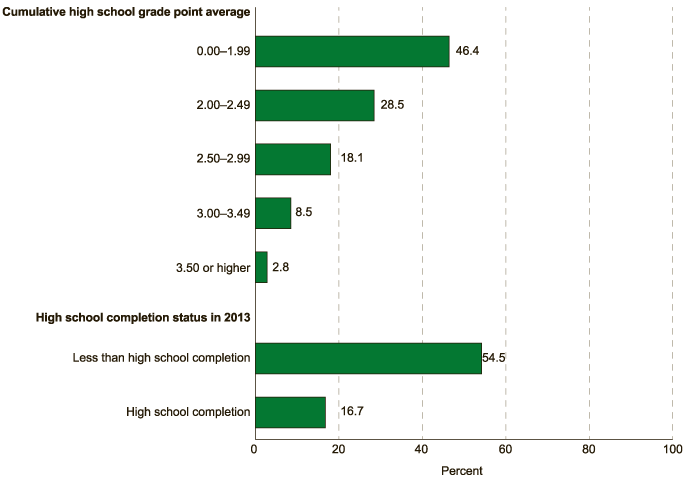By Lauren Musu-Gillette
Suspensions and expulsions from school are often associated with negative academic outcomes, such as lower levels of achievement and higher dropout rates.[i] Using data from the High School Longitudinal Study of 2009 (HSLS:2009), NCES recently published a new spotlight feature in Indicators of School Crime and Safety that shows that a greater percentage of students who are suspended or expelled have low engagement in school and are less academically successful.
While there is a large body of research on this topic, this is the first time that the nationally representative HSLS study has been used to examine outcomes for and characteristics of suspended and expelled youth. The comparisons presented here cannot be used to establish a cause-and-effect relationship, but the longitudinal nature of the dataset could provide researchers an analytical path to understanding how these relationships have unfolded over time.
Research shows that students’ attitudes toward school are associated with their academic outcomes, and that schools with a supportive climate have lower rates of delinquency, including suspensions and expulsions.[ii] As part of the HSLS:2009 data collection, students reported on their school engagement[iii] and sense of school belonging[iv] in the fall of their ninth-grade year (2009). A greater percentage of students who were suspended or expelled between 2009 and 2012 were reported low school engagement entering high school. A similar pattern was seen with regard to a sense of belonging in school.
Percentage of fall 2009 ninth-graders who were ever suspended or expelled through spring 2012, by school engagement and sense of school belonging: 2012

1A school engagement scale was constructed based on students' responses to questions about how frequently they went to class without homework done, without pencil or paper, without books, or late.
2A school belonging scale was constructed based on the extent to which students agreed or disagreed that they felt safe at school, that they felt proud of being part of the school, that there were always teachers or other adults at school they could talk to if they had a problem, that school was often a waste of time, and that getting good grades was important to them.
Source: U.S. Department of Education, National Center for Education Statistics, High School Longitudinal Study of 2009 (HSLS:2009).
The percentages of students who had ever been suspended or expelled were higher for those students with lower grade point averages (GPAs). Nearly half of students with a cumulative high school GPA below 2.0 had ever been suspended or expelled and just 11 percent had a GPA of 3.0 or higher. Additionally, as of 2013, a higher percentage of students who had not completed high school than of students who had completed high school had ever been suspended or expelled (54 vs. 17 percent).
Percentage of fall 2009 ninth-graders who were ever suspended or expelled through spring 2012, by cumulative high school grade point average and high school completion status: 2013

Source: U.S. Department of Education, National Center for Education Statistics, High School Longitudinal Study of 2009 (HSLS:2009).
Differences in the demographic characteristics of students who had ever been suspended or expelled were similar to those found in other datasets, such as the Civil Rights Data Collection (CRDC). Characteristics of youth in the HSLS study who were ever suspended or expelled include:
- A higher percentage of males (26 percent) than of females (13 percent) were ever suspended or expelled.
- A higher percentage of Black students (36 percent) than of Hispanic (21 percent), White (14 percent), and Asian students (6 percent) had ever been suspended or expelled.
- A higher percentage of students of Two or more races (26 percent) and Hispanic students had ever been suspended or expelled than White students.
- A lower percentage of Asian students than of students of any other race/ethnicity with available data had ever been suspended or expelled.
For more information on the characteristics of students who have ever been suspended or expelled, please see the full spotlight in Indicators of School Crime and Safety 2015.
[i] Christle, C.A., Nelson, C.M., and Jolivette, K. (2004). School Characteristics Related to the Use of Suspension. Education and the Treatment of Children, 27(4): 509-526.; Skiba, R.J., Michael, R.S., Nardo, A.C., and Peterson, R.L. (2002). The Color of Discipline: Sources of Gender and Racial Disproportionality in School Punishment. Urban Review, 34(4): 317-342.
[ii] Morrison, G.M., Robertson, L., Laurie, B., and Kelly, J. (2002). Protective Factors Related to Antisocial Behavior Trajectories.Journal of Clinical Psychology, 58(3): 277-290; Christle, C.A., Jolivette, K., and Nelson, C.M. (2005). Breaking the School to Prison Pipeline: Identifying School Risk and Protective Factors for Youth Delinquency. Exceptionality, 13(2): 69-88.
[iii] School engagement measured how frequently students went to class without homework done, without pencil or paper, without books, or late.
[iv] Sense of school belonging was measured based on the extent to which students agreed or disagreed that they felt safe at school, that they felt proud of being part of the school, that there were always teachers or other adults at school they could talk to if they had a problem, that school was often a waste of time, and that getting good grades was important to them.